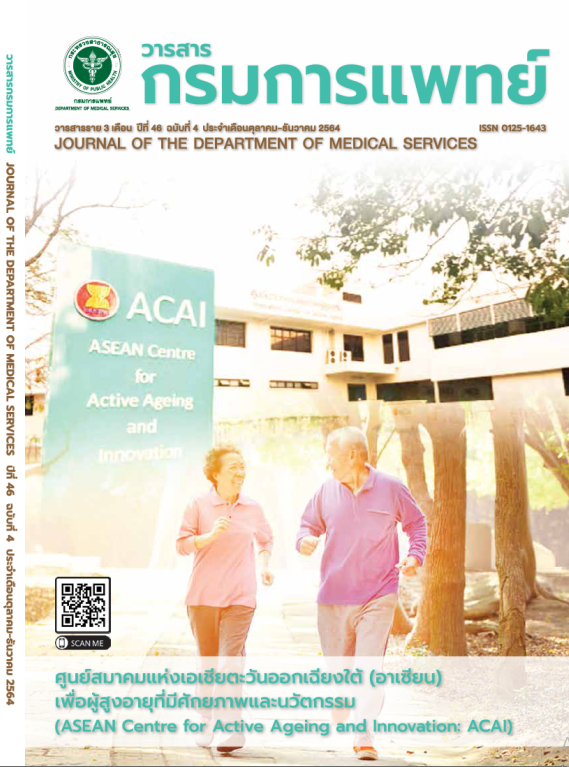การประเมินความเป็นไปได้และอรรถประโยชน์ทางคลินิกในการใช้แบบประเมินความปวด critical care pain observation tool ในผู้ป่วยวิกฤติโรคสมองที่ใช้เครื่องช่วยหายใจ
คำสำคัญ:
ความเป็นไปได้, อรรถประโยชน์ทางคลินิก, แบบประเมินความปวด, เครื่องช่วยหายใจ, ผู้ป่วยวิกฤติโรคสมองบทคัดย่อ
ภูมิหลัง: แบบประเมินความปวด Critical-Care Pain Observation Tool (CPOT) เป็นเครื่องมือประเมินความปวดที่ใช้ แพร่หลายในผู้ป่วยวิกฤติที่ไม่สามารถสื่อสารความปวดกับเจ้าหน้าที่ได้ แต่ในการนำมาใช้ในผู้ป่วยวิกฤติโรคสมองที่มีพฤติกรรมเฉพาะต่างกับผู้ป่วยวิกฤติโรคอื่น ยังไม่มีข้อมูลเพียงพอวัตถุประสงค์: เพื่อประเมินความเป็นไปได้และอรรถประโยชน์ทางคลินิกในการนำแบบประเมิน CPOT มาใช้ในกลุ่มผู้ป่วยวิกฤติโรคสมองที่ใช้เครื่องช่วยหายใจวิธีการ: เป็นการศึกษาแบบพรรณนาในโรงพยาบาลประสาทเชียงใหม่โดยให้แพทย์และพยาบาลที่ดูแลผู้ป่วยในหอผู้ป่วยวิกฤติโรคสมองจำนวน 37 คน ตอบแบบสอบถามเกี่ยวกับความเป็นไปได้และอรรถประโยชน์ทางคลินิกในการใช้แบบประเมิน CPOT โดยประเมินตัวบ่งชี้แต่ละตัวแยกอิสระต่อกันผล: ผู้ตอบแบบสอบถามทั้งหมด 29 คน ตอบแบบสอบถามดังนี้ ด้านความเป็นไปได้ในการนำมาใช้ ส่วนใหญ่ค่อนข้างเห็นด้วยว่าแบบประเมิน CPOT ชัดเจนใช้ได้เร็ว เข้าใจง่ายและให้คะแนนง่าย (ร้อยละ 54-63) และด้านอรรถประโยชน์ทางคลินิกของแบบประเมิน CPOT ส่วนใหญ่ค่อนข้างเห็นด้วยว่าแบบประเมิน CPOT มีประโยชน์ ไม่เป็นอุปสรรค ไม่ขัดต่อนโยบาย ช่วยในการปฏิบัติงานและการตัดสินใจ สื่อสารได้ง่าย และส่งผลดีต่อการปฏิบัติงาน (ร้อยละ 55-83) แต่ส่วนน้อยเห็นด้วยว่าตัวบ่งชี้ทุกตัวสามารถบ่งบอกถึงระดับความปวดในผู้ป่วยทุกโรคได้ (ร้อยละ 39-46)สรุป : มีความเป็นไปได้และอรรถประโยชน์ทางคลินิกในการนาแบบประเมินความปวด CPOT มาใช้ในกลุ่มผู้ป่วยวิกฤติโรคสมองที่ใช้เครื่องช่วยหายใจแต่ตัวบ่งชี้หลายตัวไม่สามารถบ่งบอกถึงระดับความปวดในผู้ป่วยบางรายได้
เอกสารอ้างอิง
Rangel-Castilla L, Gopinath S, Robertson CS. Management of intracranial hypertension. Neurol Clin 2008;26:521–41.
Gordon DB, Dahl JL, Miaskowski C, McCarberg B, Todd KH, Paice JA, et al. American pain society recommendations for improving the quality of acute and cancer pain management: American Pain Society Quality of Care Task Force. Arch Intern Med 2005;165:1574-80.
Payen JF, Bosson JL, Chanques G, Mantz J, Labarere J. Pain assessment is associated with decreased duration of mechanical ventilation in the intensive care unit: a post Hoc analysis of the DOLOREA study. Anesthesiology 2009;111:1308-16.
Hamill-Ruth RJ, Marohn ML. Evaluation of pain in the critically ill patient. Crit Care Clin 1999; 15:35-54.
Kwekkeboom KL, Herr K. Assessment of pain in the critically ill. Crit Care Nurs Clin North Am 2001;13:181-94.
Azzam PN, Alam A. Pain in the ICU: a psychiatric perspective. J Intensive Care Med 2013;28:140-50.
Jean-Francois P, Olivier B, Jean-Luc B, Anna L, Eric N, Isabelle D, et al. Assessing pain in critically ill sedated patients by using a behavioral pain scale. Crit Care Med 2001;29:2258-63
Gélinas C, Fillion L, Puntillo KA, Viens C, Fortier M. Validation of the critical-care pain observation tool in adult patients. Am J Crit Care 2006; 15:420–7.
Gélinas C, Harel F, Fillion L, Puntillo KA, Johnston CC. Sensitivity and specificity of the critical-care pain observation tool for the detection of pain in intubated adults after cardiac surgery. J Pain Symptom Manage 2009;37:58-67.
Nurnberg Damstrom D, Saboonchi F, Sackey PV, Bjorling G. A preliminary validation of the Swedish version of the critical-care pain observation tool in adults. Acta Anaesthesiol Scand 2011;55:379-86
Stilma W, Rijkenberg S, Feijen HM, Maaskant JM, Endeman H. Validation of the Dutch version of the critical - care pain observation tool. Nurs Crit Care 2019;24:132-40
Emsden C, Schafer UB, Denhaerync K, Grossman F, Frei IA, Kirsch M. Validating a pain assessment tool in heterogenous ICU patients: is it possible. Nurs Crit Care 2020;25:8-15.
Wongtangman K, Chaiwat O, Suraseranivongse S, Thikom N, Sanansilp V, Wangnamthip S. Validation of the Thai version critical care pain observation tool and behavioral pain scale in postoperative mechanically ventilated ICU patients. J Med Assoc Thai 2017;100:9-16.
Gélinas C, Johnston C. Pain assessment in the critically ill ventilated adult: validation of the critical-care pain observation tool and physiologic indicators. Clin J Pain 2007;23:497-505.
Devlin J, Skrobik Y, Gélinas C, Needham D, Slooter A, Pandharipande P, et al. Executive summary: clinical practice guidelines for the prevention and management of pain, Agitation/Sedation, Delirium, Immobility, and sleep disruption in adult patients in the ICU. Crit Care Med 2018;46:1532-48.
Roulin MJ, Ramelet AS. Behavioral changes in brain-injured critical care adults with different levels of consciousness during nociceptive stimulation: an observational study. Intensive Care Med 2014;40:1115-23.
Gélinas C, Boitor M, Puntillo KA, Arbour C, Topolovec-Vranic J. Cusimano MD, et al. Behaviors indicative of pain in braininjured adult patients with different levels of consciousness in the intensive care unit. J Pain Symptom Manage. 2018; 57:761-73.
Gélinas C. Nurses’ evaluations of the feasibility and the clinical utility of the critical-care pain observation tool. Pain Manag Nurs 2010;11:115-25.
Maatouk H, Al Tassi A, Fawaz MA, Itani MS. Nurses’ evaluation of critical care pain observation tool (CPOT) implementation for mechanically ventilated intensive care patients. Data Brief 2019;25:103997.
Arbour C, Choinière M, Topolovec-Vranic J, Loiselle C, Puntillo K, GélinasC. Detecting pain in traumatic brain-injured patients with different levels of consciousness during common procedures in the ICU: typical or atypical behaviors? Clin J Pain 2014;30:960-9
Joffe AM, Mc Nulty B, Boitor M, Marsh R, Gélinas C. Validation of the critical-care pain observation tool in brain-injured critically ill adults. J Crit Care 2016;36:76-80.
Richard-Lalonde M, Bérubé M, Williams V, Bernard F, Tsoller D, Gélinas C. Nurses’ evaluations of the feasibility and clinical utility of the use of the critical-care pain observation tool-Neuro in critically ill brain-injured patients. Science of Nursing and Health practices 2019;2:2.
Gélinas C, Bérubé M, Puntillo KA, Boitor M, Richard-Lalonde M, Bernard F, et al. Validation of the critical-care pain observation tool-neuro in brain-injured adults in the intensive care unit: a prospective cohort study. Crit Care 2021;25:142.
Heale R, Twycross A. Validity and reliability in quantitative studies. Evid Based Nurs 2015;18:66-67.
ดาวน์โหลด
เผยแพร่แล้ว
รูปแบบการอ้างอิง
ฉบับ
ประเภทบทความ
สัญญาอนุญาต
ลิขสิทธิ์ (c) 2022 กรมการแพทย์ กระทรวงสาธารณสุข

อนุญาตภายใต้เงื่อนไข Creative Commons Attribution-NonCommercial-NoDerivatives 4.0 International License.
บทความที่ได้รับการตีพิมพ์เป็นลิขสิทธิ์ของกรมการแพทย์ กระทรวงสาธารณสุข
ข้อความและข้อคิดเห็นต่างๆ เป็นของผู้เขียนบทความ ไม่ใช่ความเห็นของกองบรรณาธิการหรือของวารสารกรมการแพทย์



